Is it cuteness or a human printing press?
Release Date: November 5, 2020
Last Updated: February 18, 2022
Harmless cuteness or ‘human printing‘ press?
As the holiday season fast approaches and our minds turn to Christmas cards, crafts and calendars. We respectfully ask educators to pause for a moment.
Are you trapped in the cycle of tradition and creating hand and footprint crafts (craptivities) ?
Looking for those cute hand or foot print crafts that you could replicate within your Early Years settings? Trying to find a cute design that will outdo last years creations.


Are you under the assumption that parents want a beautifully crafted and comical card?
Do you sit for hours, cutting and gluing multiple hand prints to ensure every child gets a card to take home?
Many may dismiss this reflection and proceed to continue with you ‘human printing press’ activity (hand and foot print art )
Closing ears and minds to the possibility of change. It’s a long standing debate isn’t it and one that has been going on for years?
Let’s face it, the title that has many annoyed before even reading further. Perhaps many are still recovering from our previous posts using the title ‘ Craptivities?’ The post went viral and it got people talking and discussing the subject of products in Early Years. Whether you thought that title inappropriate, we apologise if you took offence. But we cannot apologise for helping others to learn, listen and reflect on practice ?
It’s about uniting us on a mission to place children at the centre of everything we do. To see our common ground.
OUR WHY?
As Early Years professionals it’s important we keep an open mind, by being open minded as adults we can look to see disagreement as a thoughtful means to expand knowledge. Instead of getting angry, let’s identify where the disagreement lies, so that we may correct misperceptions, discuss, debate and move forward for the good of the children we serve.
We do understand practitioner’s love of hand print craft, because we too, used to participate in foot or hand print crafts at the start of our careers, we too have been through the cycle of Christmas card crafts and eventually a cycle of change.
As humans, we only know what we know. We get stuck and trapped in previous learning. However, sometimes it’s important to unlearn old habits and set new wheels in motion, to adapt to changing times and improve professional practice for the children we serve.
To open up our hearts and minds, lets look at hand print art !
Where is the child in all of this ? Are they the most important thing at this time or is the card the main focus ?
The product, the end result?
Let’s consider what happens when this military (cute Christmas card operation) commences and the wheels of the ‘human printing press’ are fired up. How are these foot print crafts are really created and are they really worth it ?
Does this following scenario sound familiar?
The adults choose the design, outdoing the cuteness from last year.
The adults tick list is printed off, to ensure every child is accounted for.
List prepared, children are systematically called to the adult’s ‘Christmas card work station.’
Perhaps sadly called from their play, their engagement interrupted at a time where deep learning, laughter and connections were taking place ? Carefully and precisely the adult’s painting begins !
Either a child will sit quietly conforming as their wrist is held and paint is applied to palm and fingers. Or they engage with us, chat with us as WE the adults paint.
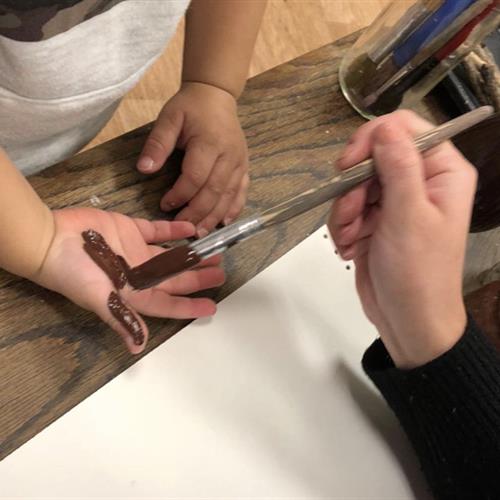
We convince ourselves it’s a beautiful sensory experience “It tickles doesn’t it, we laugh. Or if you consider a different perspective, children are passive participates in the activity. Complying and conforming. Following the adult’s instructions. Doing as they are told?
Shouldn’t we be allowing our children the autonomy and freedom to express themselves, to feel the paint in the hands, and between their toes. To move, experience and to be active participates in the process. Is this what ‘Characteristics of effective learning tells us ?
Head, heart and hands
Playing and exploring – engagement
Finding out and exploring, Playing with what they know, Being willing to ‘have a go.
Active learning – motivation
Being involved and concentrating, Keeping trying, Enjoying achieving what they set out to
Creating and thinking critically – thinking
Having their own ideas, Making links, Choosing ways to do thing.
Let’s continue with the traditional scenario
As adults, turn the child’s hand or foot over and press it firmly onto the crisp white card, take time to pause and consider, how much is the child complying or are they just a human stamp in our hand. This is why we used the title ‘ Human printing press.’


Jeanne de Clisson of EYL Pirates says
“I just don’t think using children as human stamps so that educators can adulterate them by cutting them out and adding bits and pieces to them is a worthwhile venture.”
https://eylfpirates.wordpress.com/2015/01/30/jeanne-de-clisson-and-the-human-stamp/
Harsh ? It may hit a painful cord and we implore you to pause and keep that open mind. This isn’t about us, it’s about making a change for the children we serve.
Ask yourselves the question.....
Are children hands and feet TOOLS to be used to create a cute and comical card, isn’t it time we reconsidered how appropriate foot or hand print art really is?
Still not convinced ? Let’s see how the The human printing press conveyor belt continues, the children are allowed to go off and play now and the imprints are left to dry.
Once dry it then becomes a mammoth task to cut each foot or hand print and out and as dedicated Early Years professionals, it often falls on us adults to take work home and sit for hours cutting up and down every finger. This part is beyond the capabilities of our youngest children and so again its the adult who takes charge.
With a child’s name on the back of each imprint, it’s the adult who glues each one onto the neatly folded A4 card. Remembering to write
the child’s name on the back of the card for easy identification. Especially when 30 identical cards swing from the washing line across the room. How
will we know which is which, they all look the same ?


Final stages now and the adult draws or sticks CUTE characteristics into place and slowly the hand print or foot print turns into a something recognisable.
A robin, penguins or that reindeer as mentioned before. Something seen on many a Pinterest page !

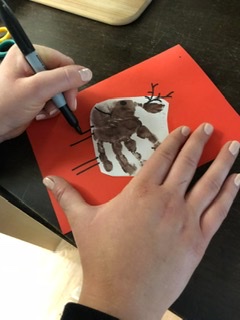
Remember it clearly states in development matters that
“In planning activities, ask yourself: Is this an opportunity for children to find their own ways to represent and develop their own ideas? Avoid children just reproducing someone else’s ideas!”
Let’s reflect....
Who participated in making of the card ?
Yes, parents may have a keep sake a moment captured in time - but hand prints or foot prints can be captured in other less obtrusive ways.
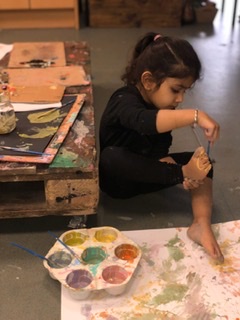
Still not convinced ?
It’s time for the cards to go home now and as proud adults we watch as parents receive their gifts. The silent pretence begins!
The parents are happy to receive anything their child gives them, a stone a leaf, even a half chewed crisp. So obviously they love the card that is given to them.
They undoubtedly love to see the handprint, a memory encapsulated on card for eternity.
But let’s not underestimate our parents and carers. They know their child didn’t create this card, they may have been used as part of the end result but as they watch 10 other identical reindeer cards marching out the door.

They know their 10 month old baby did not have much of a hand (pardon the pun) in this creation.
Let’s reflect ! Will children be able to tell parents and carers about the card that is being sent home? Was there opportunity for them to become deeply immersed in its creation, heart and soul?
To consciously connect with who they are creating it for? Or are they sadly just on a conveyor belt line, unconnected and uninterested participates in the adults Christmas card agenda?
Take time to ponder and decide?
*
*
PLEASE - Let go of their ankles and wrists and set the children free to express themselves.


Dismantle the conveyor belt, ‘human printing press’ and enjoy being present in the moment with these children as they create, paint, discover explore and express their emotions. As they create something, UNIQUE to them!
We know many educators love making the cards! Love the creation and work to send something home to the families.
But, it’s not about US, it’s not about cuteness or outdoing last years creations.
It’s about the children and connection of head, heart and hands. It’s Them being involved in the process of doing that counts.
That THEY created it, they painted or glued it.
Cute ‘human printing press’ cards? You decide?
To give you some alternative ideas we have added some below
Bauble rolling

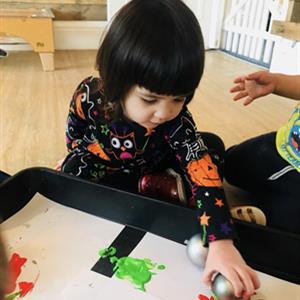
Allow little ones to get fully immersed in the discovery of paint, roll baubles and let the children make marks.
Painting a canvas
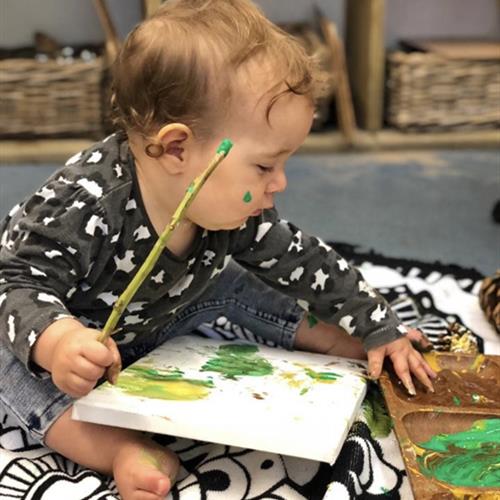
Budget shops sell canvases that are reasonable to purchase. If you want parents and carers to receive an utterly unique gift that can double as a card. This experience follows process art with out focussing on an end result.
Transient Art
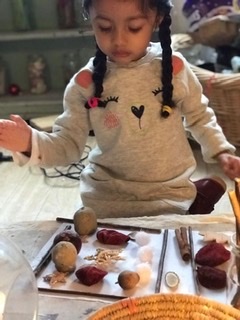
Provide children with loose parts and allow them to create their own piece of art work of a tray or within a frame. Transient art is simply art without glue! Take a photo of the children’s creations and use this for the child’s card. We would also recommend taking a photo of the child engaged in the process and include this inside the card. This will give parents and carers an insight into when and how the masterpiece was created.
These are just a few ideas for process art that can be given as gift.
Written by Stephanie Bennett

For more inspiration why not join us on The Curiosity Approach Crib ? Follow the link below
https://www.thecuriosityapproach.com/subscriptions
For further reading about process art and the difference between products we have added TWO further readings here too
https://www.thecuriosityapproach.com/blog/process-over-product
https://www.thecuriosityapproach.com/blog/stop-the-craptivities
Are you curious to see how well you are implementing The Curiosity Approach?
Take the quiz here
Copyright ©The Curiosity Approach 2021 All Rights Reserved
All files and information and images contained in this Website or Blog are copyright-protected by The Curiosity Approach Ltd, and may not be duplicated, copied, modified or adapted, in any way without our written permission. Our Website or Blog may contain our service marks or trademarks as well as those of our affiliates or other companies, in the form of words, images, graphics, and logos. Your use of our Website, Blog or Services does not constitute any right or license for you to use our service marks or trademarks, without the prior written permission of The Curiosity Approach Ltd. Our Content, as found within our Website, Blog and Services, is protected under UK and foreign copyrights. The copying, redistribution, use or publication by you of any such Content, is strictly prohibited. Your use of our Website and Services does not grant you any ownership rights to our content


